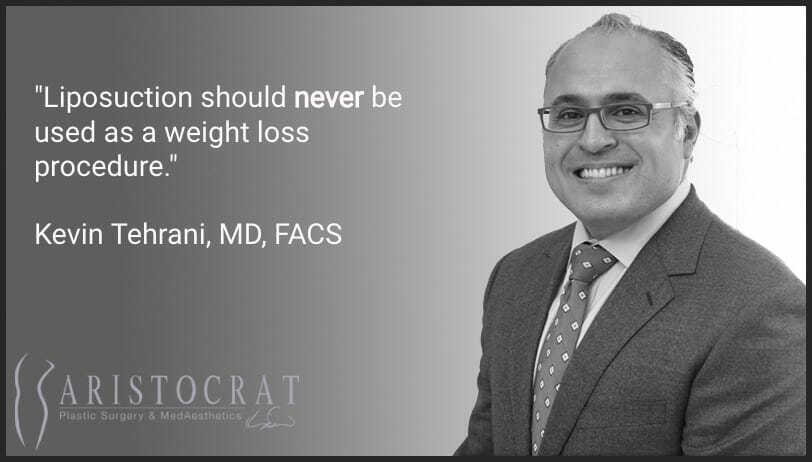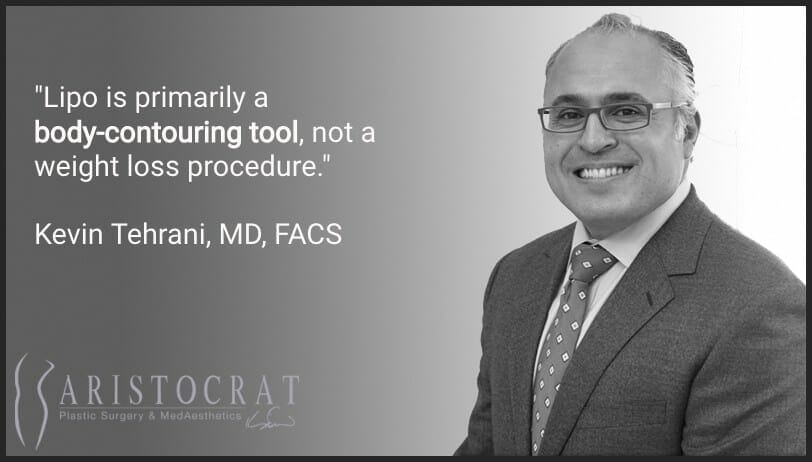Teenagers are turning to liposuction as a be-all-end-all solution to their weight problems. Unfortunately, the procedure can only do so much, and there’s no way to address these issues surgically without putting the patient at significant risk.
In 2012, as many as 236,000 teenagers had undergone plastic or cosmetic surgery in the U.S., according to the American Association of Plastic Surgeons—that’s 2 percent more than the previous year. Of these, around 3,000 annually are liposuction procedures.
While the number only constitutes 1.6% of total plastic and cosmetic surgery procedures done, it is still a worrying statistic.
It’s not that liposuction is unsafe for teens. While there may be additional precautions to take, the issue is with the why teenagers are increasingly turning to plastic surgery as a solution to their problems.

Many teens feel extremely self-conscious about their appearance. In the world of Instagram, perfectly shaped actors and musicians and Jersey Shore, it is difficult to live up to the image the society sets on our young ones.
One of the biggest insecurities many girls have is weight. Once they give in to exercise and fail to see results from masochistic diets, they start exploring cosmetic and surgical options to deal with their weight, such as liposuction.
Unfortunately, liposuction (or any plastic surgery, for that matter), is not a weight loss tool.
What liposuction can do:
- Get rid of stubborn fat pockets that do not respond to diet or exercise
- Reduce underarm fat
- Remove “love handles”
- Remove “double chin”
- Increase thigh gap
- Motivate you to live a healthier, more active life
What liposuction can’t do:
- Help lose weight
- Remove significant amounts of bad
- Remove fat equally from across your entire body
Precisely because of these unhealthy expectations, many surgeons will opt out of operating patients under 18, even though it’s legal to go for liposuction even at a younger age with parental consent.
Here at Dr. Tehrani’s practice, we’ve had a few cases where models under 18 requested lipo. They had their parents’ blessing and were happy with the results. Models, however, have a clear and relatively cold-blooded assessment of the situation, which enables them to make informed, unemotional, weighed decisions. They’re not merely trying to solve their inner insecurities via the surgeon’s knife—they’re looking to sculpt their bodies here and there to further facilitate their careers.

Most teens should think twice before undergoing liposuction.
For one, it probably won’t achieve the results you’re looking for. While liposuction can do wonders in treating stubborn fat pockets, it cannot produce a dramatic overall change. It will also lead to minimal scarring and some downtime—all of which can worsen your emotional wellbeing, rather than improving it. In fact, some teens report feeling worse about themselves after lipo.
It is also important to take into consideration that at and under 18, your body is still very much maturing and changing. Even if liposuction does achieve a satisfactory outcome, it may not last as your body changes. Focusing on your nutrition and fitness is the only true way to achieve a change that lasts. For teens that are battling insecurities or are being bullied, counselling can help.
If you do decide to go through with the procedure, there are a couple of things you should know.
Liposuction is a body-contouring tool, which means that it can remove fat from very targeted locations in your body. However, to keep the new appearance, a healthy lifestyle is imperative. If you do not watch your nutrition or fitness after liposuction, the results will quickly fade. That’s why for teenagers with obesity problems, bariatric surgery may be a better choice.
Much like with any surgery, there are risks involved in undergoing liposuction. Swelling around the incision site, dizziness due to loss of fluids, blood clots, small scars and infections are all possible side effects of liposuction.
Lastly, depending on the exact surgical technique used for your procedure, you may need up to 3 weeks of homestay recovery. That can seriously interfere with a teenager’s school and social schedules. Once again, this is the type of thing that can actually make things worse for a teenager.
If you are a teenager looking to get liposuction (or a parent of one), do not hesitate to contact Dr. Tehrani for an initial consultation. The Doc will walk you through the risks and will suggest the best path for you to achieve what you really want to achieve.

The Story of Big Brooke
Brooke Bates weighed 180 lbs by her 11-th birthday. Her chubbiness gradually lost its cuteness as she went from toddler to a teenager. In family gatherings, her cousins and uncles would call her Big Brooke—not a nickname you want to stick. At 11, however, it’s still too early to ring the alarm.
Things got worse. Her unusually high blood pressure—and a later diagnosed condition of prediabetes—let her to gain 100 more pounds in the next 12 months. She was 5’5’’, size 22, and classified as “morbidly obese” by her doctor.
“I used to think of myself as a giant balloon,” Brooke confessed when she was 13. “Always expanding.”
It’s not like she didn’t do everything in her power to lose weight. She was on a strict diet for most of her childhood, and her parents even engaged her in low-carb plan that cost them $1,400. That was in third grade. By fifth grade, the family already tried Richard Simmons’s Deal-a-Meal—a popular weight loss diet plan—and enrolled her in a Weight Watchers program.
At home, parents would scan rooms for chips, crackers, cookies and everything else that seemed less than healthy. Even though Brooke sometimes managed to lose a few pounds, she would always go back to her usual state. Her mother, Cindy, said that “Brooke seemed to be the kind of girl who gained weight from just looking at food.”

Then, on one September night, Brooke’s attention was caught by a liposuction documentary on the telly. She saw how the cannula—the narrow tube through which fat deposits are pumped out—could be the solution to her seemingly unbeatable problem.
Her parents, however, weren’t too enthusiastic about the idea. They hated the idea of putting their child through the surgical journey. “I thought, ‘Do we really want to put our child through this? There’s going to be considerable pain.’ But Brooke was determined,” says Joey, Brooke’s father.
Gastric bypass surgery was not an option, as a family friend had died from it. As Brooke kept badgering her father about liposuction, he promised “he’d look into it.”
As he started approaching surgeons, the family quickly learned about the severity of Brooke’s situation. Even Dr. Robert Ersek, who was nicknamed “The Biggest Fat-Sucker in Texas”, refused to operate on the unfortunate girl at first. Only after he learned Brooke was diagnosed with bladder cancer he agreed to take her as a patient.
35 lbs of fat had been extracted from Brooke’s body. The volume of fat is a poor metric to measure liposuction success, but, for context, she is considered the biggest liposuction patient in the country. Usually, only up to 10 lbs of fat is removed per liposuction procedure.
“We don’t have any experience with people who are 12, with that kind of surgery,” says Dr. Peter Fodor, a past president of the American Society for Aesthetic Plastic Surgery. “Metabolically, her whole system is still growing.”
Looking at Brooke today, a couple of years after the procedure, one would be shocked to learn she once weighed 220 pounds. She did indeed turn to a healthier, more active lifestyle.
However, the transformation came at a tremendous cost.
“The first week was pretty rough,” says Joey, who slept on his daughter’s floor for several nights. “Brooke was in a lot of pain; she was so sore she couldn’t get off the bed by herself. It was hard on all of us. But each day she felt better. It helped that she was getting smaller and smaller.”

Due to the volume of her liposuction procedure, Brooke was left with a lot of loose, hanging skin. Thus she had to go back to her surgeon for a tummy tuck procedure, during which the excess skin was removed. The surgery removed another 10 lbs of fat from Brooke’s body, and she lost 20 pounds soon after purely due to healthier habits.
As a result, Brooke gained some confidence and comfort with her own body. “The mirror used to be my worst enemy,” says Brooke, who is down to 155 lbs. “But now it’s my best friend.”
This is a story with a happy ending, but it must be said that what Brooke went through was extremely dangerous. Liposuction should never be used this aggressively to treat obesity. It’s not what the procedure is for. The surgery put the girl under immense risk. It was a desperate measure, employed in a desperate situation.
The two surgeries cost the Bates twenty-five thousand, none of which was covered by their health insurance. Her surgeon, who offered the family an installment plan, said that he only agreed to operate Brooke due to her optionless situation. Her parents, even under a significant financial burden, are happy with the results:
“For a kid who has basically been on a diet from the age of 3, this is just wonderful,” says Cindy. “There is no way something like that would have happened for her with just dieting.” Adds Joey: “Her self-esteem and improved health make it worth every penny.”
Today, Brooke eats Special K cereal, fruit or poached eggs for breakfast, salad with chicken for lunch, grilled meat or fish and vegetables at dinner.
She’s much more active, too: running, self-defense classes, rope jumping—you name it. She even learned to say no to midnight trips to the fridge. Brooke today confidently wears a size 10 polka-dot dress, and her cancer is “in remission.”
Oh, and the dress she used to wear a couple of years ago? It’s too big now.
Liposuction in a Nutshell
There are several slightly different liposuction techniques available, however they all work under the same general principle:
- A tiny tube (called a cannula) is inserted through a small incision in the treatment site
- The fat deposits in the treatment site are distorted through the movement of the cannula
- The fat is suctioned out through the tube
Where liposuction methods do differ is the way they help distort the fat deposits.
The most common method is when a sterile solution is administered into the treatment site. The solution contains salt water enhanced with lidocaine and epinephrine. These agents make fat removal easier, while minimizing blood loss and post-op pain.
Ultrasound liposuction—or UAL—uses sound waves to distort fat cells underneath the skin. The ultrasound liquifies the fat, which makes it easier for the surgeon to remove the target tissue.
Much alike, laser liposuction—also referred to as SmartLipo—uses the energy of light to liquefy the fat deposits. Both methods work with similar efficiency. The final decision on what method to use depends on the surgeon’s experiences and preferences.
Final Verdict: Liposuction Is (Probably) Not the Answer
For whatever reason you might want to undergo liposuction at an age this young, liposuction is most likely not the answer to the solution. The story of Brooke Bates, although inspiring, can be misleading. In her case, the only reason such a risky procedure was performed was because she was already in a pretty desperate spot.
The absolute majority of teenagers should focus on their nutrition and lifestyle choices before even considering liposuction as a weight loss tool. Even in Brooke’s case, it was the lifestyle change that produced a permanent change, even if the surgery was the catalyst.

